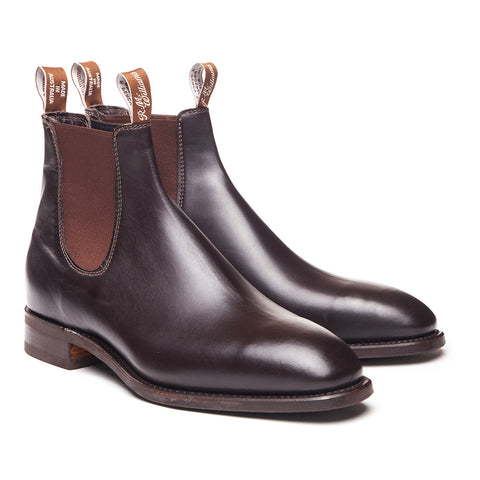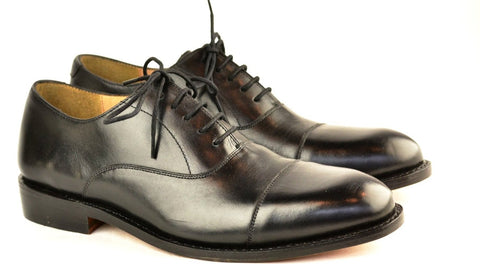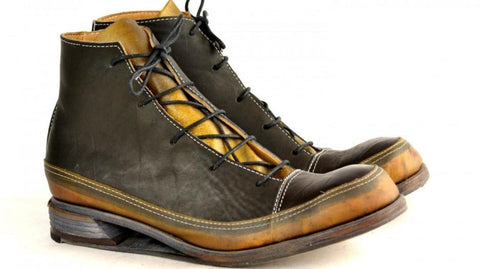Men's boots and classic shoes
Aug 06, 2018
THE COMPLETE GUIDE TO
MEN’S BOOTS AND CLASSIC SHOES
In our increasingly globalised world, men’s fashion has boomed. Yet with greater choice comes a whole host of confusing sartorial rules and terms – we’ve come a long way from the go-to jeans and sneakers ensemble. But for those among us who couldn’t tell a Derby from a Brogue, we’re here to help you navigate the complex, seemingly inexplicable world of men’s boots and shoes.
This article is the first instalment in our series and focuses on men’s boots. We commence our guide with a quick voyage through the history of boots and shoes in general. Armed with this account, we’ll walk you through the various leathers used in shoe making as while not adequately recognised in the mass market, leather is pivotal in the look and feel of your boots and shoes - defining the character of your footwear and determining how and when you should wear each pair.
Thoroughly briefed on the leathers typically used in a high-end build, we’re ready to then start talking about the style. Every silhouette has a history and a strict code of conduct. Where should you expect to find an Oxford shoe? What factors make up the beautiful Brogue? What’s the difference between a Chelsea Boot and a Sneaker Boot? We answer all this and more, offering insight into the different types of footwear so you know what suits a semi-formal affair and what styles are best reserved for a casual Saturday lunch.
A brief history of boots
Etched into the walls of Spanish caves from as early as 12000 BC, boots have transcended classes and cultures across the world for thousands of years. In ancient times (where the population predominantly went barefoot), men’s boots were considered a symbol of power and military status. Adorned and ornately finished, they were worn by emperors and kings, emphasising the significant class distinction between them and their subjects.
In Australia the history of boot making is inextricably linked back to the first penal colonies. Due to the unfamiliar terrain and harsh conditions faced by the convicts, men’s boots wore out quickly. As such, some of the first shoemakers in Australia were convicts who established themselves as saddlers and leather tradesmen upon release. It wasn’t until the 1840s that the first hard wearing boots were purpose built for the Australian climate. Soon quality leather was more readily available and settlers stopped sending to the UK for their shoes. Pre-WWI, boot making boomed in Australia – a far cry from today where just 12% of footwear bought in Australia is manufactured locally.
The most important styles of men's classic footwear
Regardless of if you’re dressing for the 9 to 5 or smarting up for a formal event, there’s a men’s boot out there for you. Whether you’re looking for a lace-up half boot or zip-sided number, the key to finding the right pair comes down to a couple of factors; style, type of leather and build quality. The best men’s boots will find the perfect balance between each of these components.
Derby Boot
Featuring back quarters that are sewn on top of the vamp, the Derby is known for its open lacing construction. This look, a slightly more casual affair to the Oxford, was popularised in the mid 1800’s. While the history of the Derby is ambiguous, each theory draws from the same concept: comfort. Due to this shoe’s open lacing system, the Derby comfortably accommodates most foot shapes and sizes. As such, many say the style was an evolution of the Oxford or the traditional boots for those seeking reprieve from high insteps and unusually shaped feet. You can find our bestselling Derby (constructed from black cordovan) in the men’s boots section of the A. McDonald store.
Oxford Shoe
Distinguished by what is known as ‘closed lacing’, the Oxford shoe is often considered the more formal cousin of the ‘derby lace-up’. Popularised in the late 1880s by students at Oxford University, the dress shoe was soon increasingly worn by men and women of high society - favoured for its comfort and elegant sense of style. Traditionally the Oxford is known for its simple silhouette, however through the ages shoemakers have designed them with toecaps and brogued wingtips for interest. Just as popular today, this timeless style suits all manner of looks – paired perfectly with a sharp suit and tie for more formal occasions or on the weekend with tan chinos and a casual shirt. The A. McDonald Beauford Oxford is one of our most popular styles and effortlessly worn to Monday’s meeting and beyond.
The Brogue
Originating in Scotland where men had holes drilled in the side of their shoes to allow them to drain as they walked through marshes, the humble Brogue has come a long way. Renowned for their punch-hole design along the shoes leather upper, the brogues perforated pattern today serves decorative purposes only. Broguing is crafted using pinking shears or a sewing machine’s gimping tool and while it’s often found in Oxford or Derby styles, you won’t typically see a loafer or slip-on with these iconic holes.
When researching the best Brogue to suit your needs, there are a number of designs to select from. The first is the Quarter Brogue, the simplest design and best suited to formal occasions. The Semi-Brogue features slightly more detailing and would be worn for more casual affairs. Finally, there is the Full Brogue (also known as Wingtips in reference to the W shape at the toe) and the Longwing Brogue where the tip reaches down the side and broguing is featured across the whole shoe. The A. McDonald Oxford Brogue is a classic style reinterpreted for the modern world.

Chelsea Boot
Featured in most wardrobes, the Chelsea Boot has stood an icon for generations. Designed by Queen Victoria’s cobbler in the early 1800’s, the boot features a high ankle and elasticised sides for an easy slide. Initially worn for paddock walks and riding activities (and so dubbed the ‘Paddock Boot’), they were quickly picked up by the Chelsea society at the time. In the mid 60’s, the boot was adapted to include a Cuban heel and popular bands such as The Beatles were oft seen wearing this style. Depending on the leather used, this versatile boot can be worn to all manner of events – anything from a formal meeting to a family barbeque. Check out this helpful article that explains the details of this famous boot, and also know that R.M. Williams create some of the most well-known Chelsea boots around.

Zipper Boot
Designed for optimal support and ease of access, the Zipper Boot features a teethed zip on the side or rear quarter of the boot. Crafted to take the form of your leg, the silhouette is best constructed from a soft and malleable leather to allow the leg to move freely. We often use a mustang horse leather upper for this pattern, as seen in our Zip Sided Boot in burgundy mustang.
Sneaker Boot
Drawing inspiration from the classic sneaker silhouette, the Sneaker Boot is something of a hybrid design. Constructed from all leather upper, lining and sole, the boot features an elevated heel and sole – known for its chunky, robust impression. Typically made from bison or cordovan, this boot needs a durable, textural leather to bring out the rugged intention of its style. A great example of this is the Sneaker boot as created by the A. McDonald studio. Constructed with a welt stitch, the design integrates multiple pieces in an asymmetrical manner to juxtapose with its environment.
Conclusion
And there we have it; your comprehensive guide to men’s’ boots and classic shoes. Equipped with a solid understanding of common leathers and the diverse, often complex, features of different men’s boots, it’s time to have a bit of fun with your styling. Consider the guidelines that society has drawn, but remember that great moments in fashion often stem from throwing the rulebook out the window. For inspiration, or a custom design, take a look at the A. McDonald online store where each boot is painstakingly handcrafted from quality leathers for a truly unique finish.
We hope you’re feeling far more confident as you prepare for your next event. We want you pounding the pavement with an air of conviction and a comfortable sole. This is your comprehensive guide to men’s classic footwear, sitting here whenever you need reminding of the fibre density in Shell Cordovan leather or the lacing system applied to the Oxford boot. And if there’s anything we’ve left amiss, feel free to get in contact with the A. McDonald studio for a chat.






